Records of Natural Products
Year: 2020 Volume: 14 Issue:5 September-October
1) New Spectinabilin and Hexadienamide Derivatives from Streptomyces sp. S012
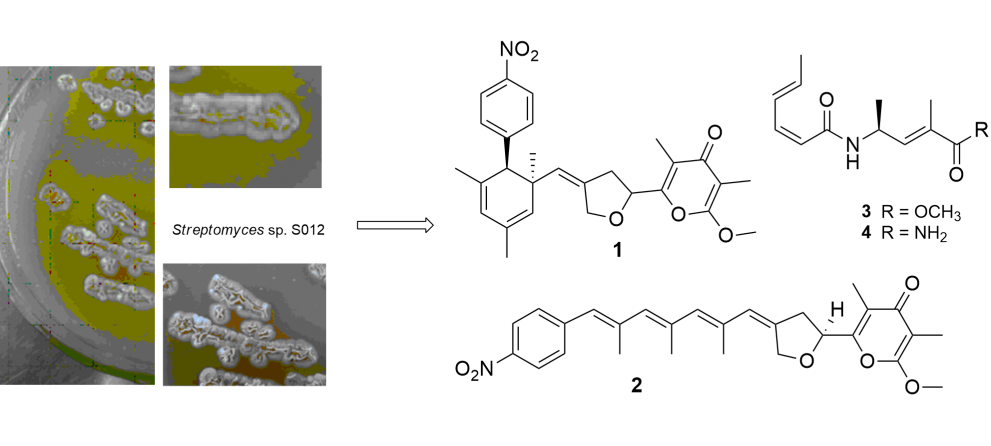
A new spectinabilin derivative (1) and hexadienamide (3), together with (-)-spectinabilin (2) and sarmentosamide (4), were isolated from Streptomyces sp. S012. Their structures were elucidated on the basis of spectroscopic analysis, including 1H, 13C NMR, 1H-1H COSY, HSQC, HMBC, NOESY and HRESIMS. Their antibacterial activity was also evaluated in this study.
DOI http://doi.org/10.25135/rnp.173.19.12.1510 Keywords Spectinabilin hexadienamide Streptomyces sp. S012 spectral data DETAILS PDF OF ARTICLE © 2020 ACG Publications. All rights reserved.2) Two New Alkaloids from Pleurotus ostreatus (Jacq. :Pers.) Roll

Pleurotus ostreatus (Jacq. :Pers.) Roll is a grey edible mushroom (Agaricochaete), containing a variety of vitamins, minerals and different kind of secondary metabolites. Two new terpenoid indole alkaloids (Terpendole N and Terpendole O) were isolated from the fermentation of P. ostreatus. Their structures were elucidated by 1D, 2D NMR, HR-ESI-MS, and ECD.
DOI http://doi.org/10.25135/rnp.166.19.11.1480 Keywords Pleurotus ostreatus (Jacq. :Pers.) Roll alkaloids spectroscopic analyses DETAILS PDF OF ARTICLE © 2020 ACG Publications. All rights reserved.3) Pomegranate (Punica granatum L.) Peel Extract: Potential Cytotoxic Agent Against Different Cancer Cell Lines
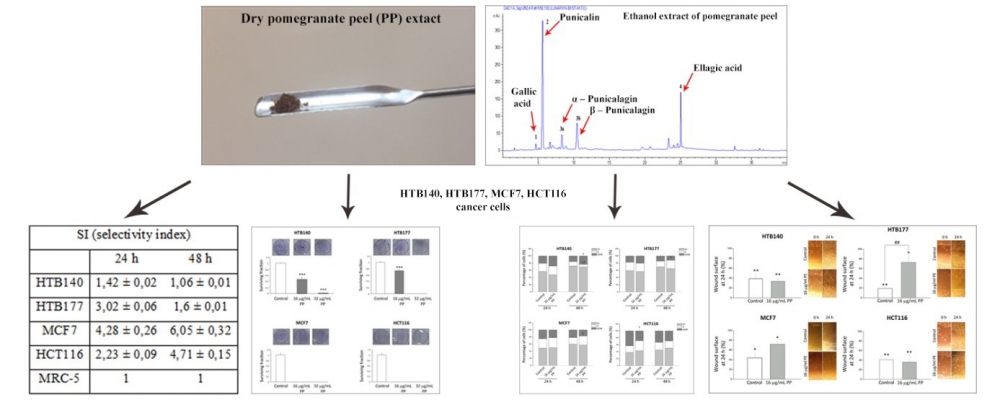
The aim of the present study was to investigate effects of pomegranate peel (PP) extract on different human cancer cell lines. MTT was performed to estimate cytotoxic effects of PP extract against HTB140, HTB177, MCF7, HCT116 human cancer cell lines and MRC-5 normal fibroblasts. Clonogenic assay was used to reveal cell survival after the treatment with PP extract. Cell cycle analysis was done using flow cytometry. Wound healing assay was applied to estimate inhibitory effects of PP extract on migration of cancer cells. The results showed that PP extract expressed selective cytotoxicity for cancer cells compared to normal cell line. Analyzed cancer cell lines displayed individual variations in sensitivity to PP extract reflected through changes in clonogenic survival, cell cycle distribution and migration, which may be due to the specific nature of each tested cell line. In conclusion, PP extract exhibits good inhibitory effects on tested cancer cell lines.
DOI http://doi.org/10.25135/rnp.170.19.11.1477 Keywords Punica granatum L. peel extract phenolic compounds cytotoxicity cancer cells DETAILS PDF OF ARTICLE © 2020 ACG Publications. All rights reserved.4) Lucilia sericata Larval Secretions Stimulating Wound Healing Effects on Rat Dermal Fibroblast Cells

The extract from larval Lucilia sericata is used clinically to promote wound healing and tissue regeneration. However, its effect and underlying mechanisms on fibroblast cells, which are involved in the wound healing process, are still poorly understood. This study aimed to examine the effects of larval secretions on dermal fibroblast activity and gene expression and to evaluate the wound healing potential of their major components. Primary rat fibroblasts were cultured and treated with larval secretions. Following the treatment, the cells were used to extract RNA for gene profiling. In addition, migration to the injury site was studied with the scratch healing assay. Our results showed that larval secretion accelerated the migration of the fibroblasts compared to the control cells and that several mRNAs were differentially expressed during a period of 72 h incubation. Additionally, we analyzed the chemical composition of larval secretions and showed that fumaric acid, ferulic acid, and p-coumaric acid, which were selected and identified for their major components, enhanced the migration of the fibroblasts. Therefore, these results indicate that L. sericata larval secretions could modulate the mRNA expression of some wound healing-related genes of the fibroblasts and contain the effective components for wound healing.
DOI http://doi.org/10.25135/rnp.180.20.03.1582 Keywords L. sericata larval secretion wound healing fumaric acid ferulic acid LC-HRMS GC-MS DETAILS PDF OF ARTICLE © 2020 ACG Publications. All rights reserved.5) Structure, Absolute Configuration and Biological Evaluation of a New Labdane Diterpenoid from Jatropha podagrica
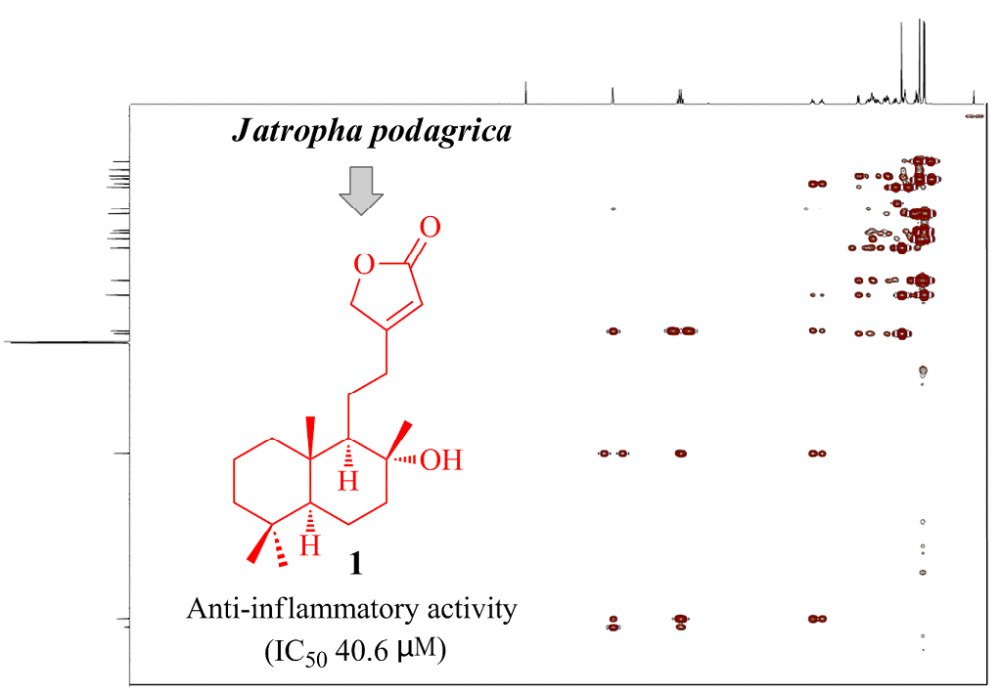
Jatrodagricaine A (1), a new labdane-type diterpenoid, together with three known derivatives (2−4) were isolated from the leaves of Jatropha podagrica. Their structures were elucidated by extensive spectroscopic methods. The absolute configuration of 1 was established by its biosynthetic pathway and comparison to known compound. All compounds were investigated for their anti-inflammatory and thioredoxin reductase (TrxR) inhibitory activities. Compound 1 showed potential inhibition in terms of nitric oxide (NO) production in lipopolysaccharide (LPS)-induced RAW264.7 macrophages with IC50 value of 40.6 ± 2.2 μM.
DOI http://doi.org/10.25135/rnp.172.1912.1495 Keywords Jatropha podagrica labdane diterpenoid anti-inflammatory activity thioredoxin reductase DETAILS PDF OF ARTICLE © 2020 ACG Publications. All rights reserved.6) A New Dopamine Derivative from Cotidius chinensis

A new dopamine derivative (1), along with three known analogues (2‒4), was isolated from the medical insect Cotidius chinensis. Their chemical structures were identified by spectral data including HR-ESI-MS, 1D and 2D NMR.
DOI http://doi.org/10.25135/rnp.176.19.12.1503 Keywords Cotidius chinensis Aspongopus chinensis dopamine derivative medical insect cotidione A DETAILS PDF OF ARTICLE © 2020 ACG Publications. All rights reserved.7) Essential Oil Composition of Tilia platyphyllos Scop. Collected from Different Regions of Kosovo
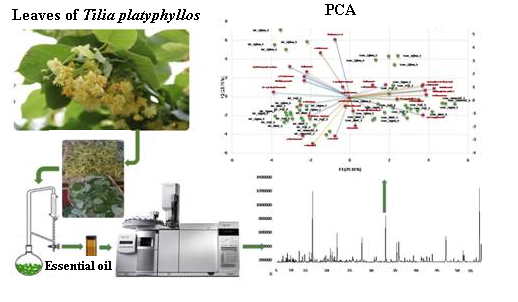
The aim of this study was to assess variation of the chemical composition of essential oils obtained from inflorescences and leaves of Tilia platyphyllos Scop. collected from five different localities in Kosovo. GC-MS/GC-FID analysis revealed the presence of 96 compounds in essential oils obtained from inflorescences of large-leaved lime with the most prominent classes including hydrocarbons, with the respective concentrations in flowers and leaves of 41.7% - 46.2% and 27.5% - 36.8%, respectively, oxygenated sesquiterpenes (12.2%-23.0% and 21.3% -31.2%, in flowers and leaves, respectively) and fatty acids and their derivatives (8.0% - 19.6% and 18.1% – 23.1% in flowers and leaves, respectively) whereas monoterpenes were present in smaller amount. Experimental data showed that large-leaved lime is reach in different groups of volatile compounds, and this species could be further recommended for food and medicinal application.
DOI http://doi.org/10.25135/rnp.171.19.11.1490 Keywords large-leaved lime essential oils principal component analysis DETAILS PDF OF ARTICLE © 2020 ACG Publications. All rights reserved.8) Antimicrobial, Larvicidal Activities and Composition of the Leaf Essential Oil of Magnolia coco (Lour.) DC
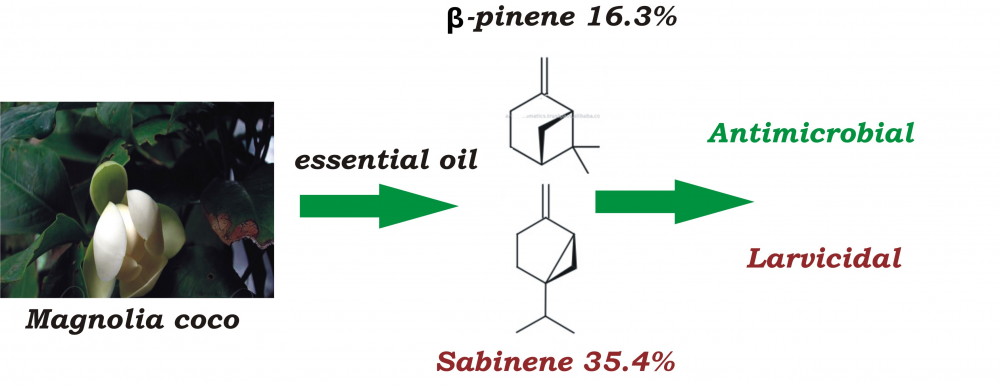
The chemical constituents, antimicrobial and larvicidal activities of essential oils obtained by hydrodistillation of the leaves of Magnolia coco (Lour.) DC. are being reported. The essential oils were analyzed using Gas Chromatography-Flame Ionization Detector (GC-FID) and Gas Chromatography-Mass Spectrometry (GC-MS) while the larvicidal activity was evaluated by the protocol of the World Health Organization (WHO). The microbroth dilution assay was used for the study of antimicrobial activity. The major compounds in the oil were sabinene (35.4%) and β-pinene (16.3%). The oil exhibited 100% mortality towards Aedes albopictus at 24 h and concentrate of 50 mg/mL while maximum mortality was shown against Ae. aegypti and Culex quinquefasciatus at concentration of 100 mg/mL. The median lethal concentrations, LC50, values of 11.01, 46.46 and 87.61 mg/mL were obtained against Ae. albopictus, Ae. aegypti and Cx. quinquefasciatus respectively at 24 h. However, the LC50 values at 48 h period were 10.40, 41.98 and 53.86 mg/mL respectively. In addition, the oil exhibited antimicrobial activity against Enterococcus faecalis ATCC 299212, Staphylococcus aureus ATCC 25923, Bacillus cereus ATCC 14579 and Candida albicans ATCC 10231 with minimum inhibitory concentrations (MIC) values of 128.0, 256.0, 128.0 and 64.0 µg/mL respectively, while the IC50 values were 64.33, 128.4, 65.33 and 32.33 µg/mL respectively. These reports, the first of its kind, indicate the potentials of M. coco leaf oil as a source of antimicrobial and larvicidal agents.
DOI http://doi.org/10.25135/rnp.174.20.02.1541 Keywords Magnolia coco essential oil monoterpenes antimicrobial activity larvicidal activity DETAILS PDF OF ARTICLE © 2020 ACG Publications. All rights reserved.9) A New Labdane Diterpene from the Aerial Parts of Chloranthus serratus
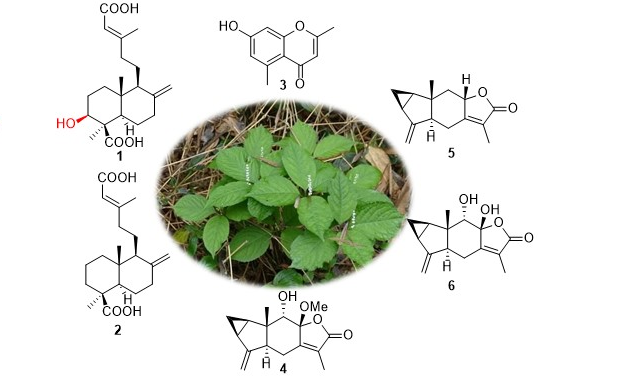
A new labdane diterpene (1) and five known compounds (2-6) were isolated from the aerial parts of Chloranthus serratus. The gross structure of compound 1 was resolved by NMR and HRESIMS data. The absolute configuration of 1 was determined by comparing CD spectrum and specific rotations with those of the co-isolated known analogue 2. The known compounds were identified to be agathic acid (2), altechromone (3), chlorajapolide F (4), shizukanolide (5), and chloranthalactone E (6) by comparing the NMR data with those in the literature. ll compounds were evaluated for their inhibitions against NO production in LPS-activated RAW 264.7 macrophages, compounds 2 and 6 showed moderate inhibitions with IC50 values of 45.2 ± 1.2 and 35.3 ± 0.9 mM.
DOI http://doi.org/10.25135/rnp.175.20.02.1559 Keywords Chloranthus serratus labdane diterpene inhibitions NO production DETAILS PDF OF ARTICLE © 2020 ACG Publications. All rights reserved.10) Scoparic acid E: A New Labdane Diterpenoid on Attenuating Palmitate Induced Viability in MIN6 Cells from Scoparia dulcis

A new labdane diterpenoid, named Scoparic acid E (1), was obtained from the medicinal plant of Scoparia dulcis L. The structure of Scoparic acid E (1) was elucidated and characterized through detailed physical analyses of its NMR spectroscopic data and HRMS. Scoparic acid E (1) was tested for its effect on attenuating palmitate-induced viability at 25 and 50 μM. The results showed that compound 1 significantly attenuated palmitate-induced viability in MIN6 cells.
DOI http://doi.org/10.25135/rnp.177.20.02.1567 Keywords Scoparia dulcis L scoparic acid E labdane diterpenoid palmitate-induced viability DETAILS PDF OF ARTICLE © 2020 ACG Publications. All rights reserved.